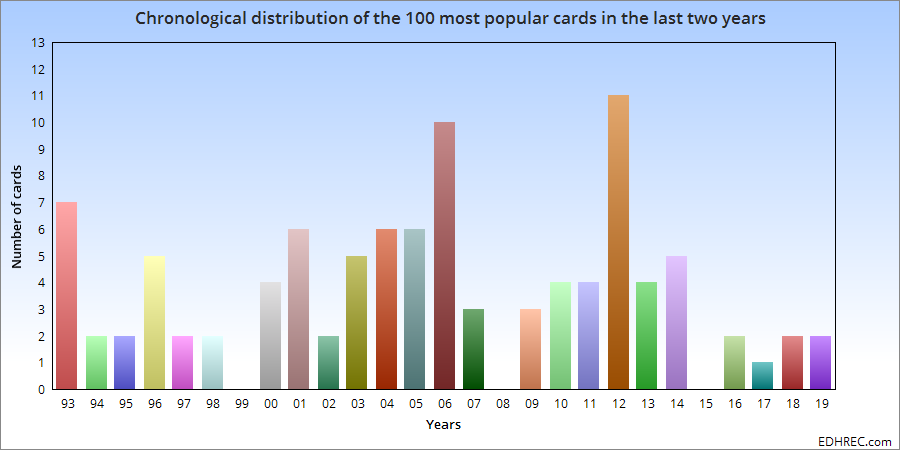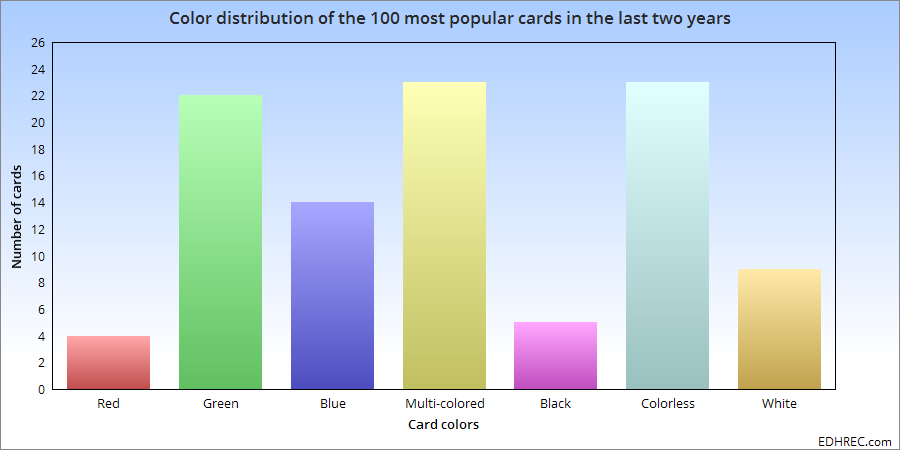Superior Numbers - Breaking Down the Top 100
100 Days, 100 Nights, to Know a Man's Heart
Welcome to Superior Numbers, where I conduct numerical analysis on cards and deckbuilding trends using just a little bit of math. Moving forward, I'm going to be doing this weekly. Yes, weekly. If you'll allow me a little bragging, I'm pretty in touch with youth culture, and I know the kids today are into Fortnite, TikTok, and bar graphs. I don't know what those first two are, but I can provide the last in spades, and the EDHREC powers-that-be wanted some of that cutting-edge action on a weekly basis.
I've used this column as a clearing house for stat-adjacent ideas that didn't really fit with my original In the Margins series, and that's exactly what we're up to today. This time I'm sating some personal curiosity by putting a bunch of numbers into a spreadsheet, which is a perfectly normal thing that normal people like myself do for fun. We're going to look at the top 100 most popular cards in the last two years, but I'm going to take that data and look at it in a way you can't break down on the website, and see if we can draw any conclusions from any of it.
To start, why don't we look at the chronological origin of cards showing up in the top 100:
Some interesting observations on this data:
- Three years have no representatives:
- 1999, containing the sets Mercadian Masques, Sixth Edition, Starter 1999, Urza's Legacy, and Urza's Destiny
- 2008, with Eventide, Morningtide, Shadowmoor, and Shards of Alara
- 2015, featuring the releases Battle for Zendikar, Commander 2015, Dragons of Tarkir, Fate Reforged, and Magic Orgins
- Urza's block, often considered one of the most broken blocks of all time, only has a single card in the top 100: Windfall
- Only 1 card in the top 100 comes from a Commander precon: Chaos Warp.
- Most expensive card in the top 100? Sylvan Library, at about $40.
- There are 0 cards from the Reserved List in the top 100.
So do we have any takeaways here?
First, cost of cards is a factor when it comes to deckbuilding. The fact that the most expensive card is just $40, the lack of Reserved List cardboard, and the absence of cards from the powerful Urza's block, where a lot of the best cards are both expensive and on the Reserved List (Gaea's Cradle, Grim Monolith, Yawgmoth's Will), seem to back this up to a degree. That's not to say Commander players won't drop a lot of money on cards, but the format certainly isn't predicated on player willingness to spend big.
Second, strong cards from Magic's recent power creep era aren't necessarily getting jammed into decks upon release. For example, there are only 7 cards in the top 100 from the last 5 years: Anguished Unmaking, Assassin's Trophy, Heroic Intervention, Rhythm of the Wild, Shalai, Voice of Plenty, Smothering Tithe, and Zendikar Resurgent. Teferi's Protection is maybe one of the strongest EDH cards printed in the last decade, and it's not showing up in the top 100, probably because a) it costs $40+, and b) it's difficult to find since it was only printed in a precon and as a Judge foil.
Third, the first two Ravnica blocks are responsible for the big spikes we see in 2006 and 2012. There are a couple of reasons for that:
- They each consist of just generally strong sets, each featuring cycles of broadly useful cards designed to help standard color pairs work well together. This shows up in the form of Signets and Charms, as well as with mana fixing like Chromatic Lantern and Farseek.
- The strong color pair focus of guilds gives us strong cards whose power level in Standard is tempered by the aforementioned color pair focus, which is less of a speed bump in Commander. Namely, we get things like Coiling Oracle, Mortify, and Putrefy. These aren't my personal favorite cards, but they're certainly ubiquitous and budget-friendly.
- The sets feature generally powerful cards with game-changing abilities in multiplayer because they were designed before WotC gave thought to how the mechanics would affect games with more than two people (e.g. Cyclonic Rift, Vandalblast).
Lastly, while we may have seen some power creep in the game overall, we've also seen a decrease in the printing of cards and mechanics that are accidentally overpowered in multiplayer, like Buyback or Overload. As power has crept up, aspects of the game that are unintentionally strong in Commander have decreased in power level, and this has possibly served to somewhat balance things out when we look back at popular cards and the the spread of old and new cards that show up in decks today.
100 Days in Desert Sand, a Drifter in No-Man's Land
Next, I'd like to take a look at the color distribution of the top 100 cards.
Less black cards than white? Black barely beating red for representation? Pineapple on pizza? Madness!
Or is it?
Mono-black is a strong color, but it can't deal with artifacts or enchantments. It has decent targeted creature removal, but if I have access to white, I'm running Path to Exile and Swords to Plowshares before any of mono-black's options, and that's not even considering W/B choices like Anguished Unmaking. If I have access to blue, I'm probably running Pongify, Rapid Hybridization, and Reality Shift first, too. Pair black with red and we now add Rakdos options like Bedevil and Terminate. Paired with green, you add Assassin's Trophy, Maelstrom Pulse and Putrefy to the discussion.
Similarly, black's strong board wipe suite isn't nearly as good as what white offers, and if paired with red, things like Blasphemous Act and Chandra's Ignition are competing for deck slots. In short, for all black's power, that power may lie in the aggregate instead of in the extremes.
The high showing from colorless cards isn't really a shock either, but a large portion of that showing is comprised of Signets and Talismans, along with other mana rocks, which are colorless cards, but obviously serve multicolored decks.
Green's strong representation also isn't really surprising. The top 100 features a heavy dose of ramp, in the form of both mana dorks and Cultivate-style spells, and blue's bracket is filled with counterspells and ways to draw lots of cards.
Despite only placing four cards in the top 100, I do think red's contributions are worth noting, namely Blasphemous Act, Chaos Warp, Faithless Looting and Vandalblast. Blasphemous Act and Vandalblast are cards whose mechanics scale better in multiplayer than were intended, as they were designed in a time before multiplayer was a significant design consideration. Faithless Looting is so strong it's now banned in Modern, and Chaos Warp is a clear color pie break. The takeaway here? If a red card is going to place in the top ranks, it better be busted in some way.
You Gave Me 100 Ways to Hate
Finally, let's break the multicolored cards down a little further:
So what jumps out here?
- No four-color sets, though that shouldn't be particularly surprising given there's only ever been ten four-color cards printed (the five C16 commanders and the five Nephilim).
- Only one five-color card, though again, statistically speaking, that makes sense because there are only 24 EDH-legal WUBRG cards in Magic's history. If anything, having one five-color card show up is a dramatic over-representation.
- There're only two three-color cards in the lot. That fits statistically, as there's both less of those cards in print and less decks for them to go into.
- A surprisingly poor showing from Simic, especially given the high numbers from mono-blue and mono-green on the previous chart, with Coiling Oracle as the sole blue-green representative here.
- There are five Orzhov cards, all of which are either targeted removal or board wipes, further strengthening my theory that the lack of black's representation in the second chart is due to there being so many good black removal spells that are tied to other colors.
- That becomes even further supported when you see that two of the three Golgari cards here are also removal spells: Assassin's Trophy and Putrefy.
And it Won't Mean a Thing in a Hundred Years
That's enough with the top 100 cards of all time for this article. There're a lot of different ways to dig into this data, and I'm going to utilize a lot of those ways to dig on in the future. Fingers crossed that none of it involves Fortnight or Tictoc. If there's anything specific you'd like me to look at, let me know in the comments below, or reach out to me on Twitter @danaroach. Thanks for reading!
Your opinions are welcome. We love hearing what you think about Magic! We ask that you are always respectful when commenting. Please keep in mind how your comments could be interpreted by others. Personal attacks on our writers or other commenters will not be tolerated. Your comments may be removed if your language could be interpreted as aggressive or disrespectful. You may also be banned from writing further comments.



